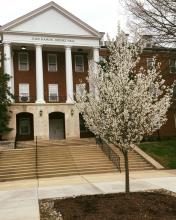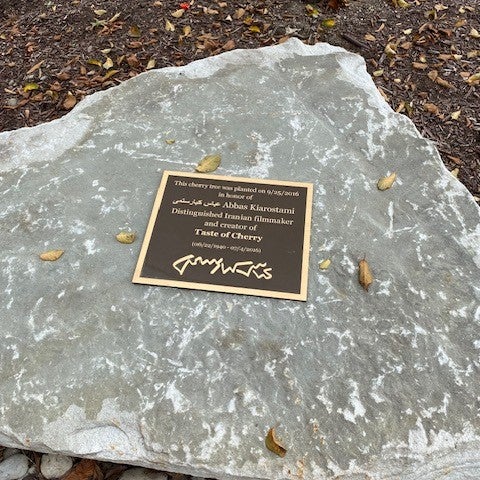Kiarostami, Abbas
About Abbas Kiarostami

A Snow Goose flowering cherry on campus is dedicated to Abbas Kiarostami, an Iranian film director. Kiarostami was born in Tehran, Iran, in 1940. He worked as a graphic designer after graduating from university with a degree in fine arts.1 He created a film section in 1969 at the Institute for Intellectual Development of Children and Young Adults, where the Iranian New Wave of film was born. At the Institute he directed some of his most famous movies until 1992, such as his first short, The Bread and Alley (1970), The Traveler (1974), and his trilogy starting with Where is the Friend’s Home? (1987). His film Taste of Cherry won the Palme d’Or in 1997, and is the reason a flowering cherry was planted in his honor. Other award-winning films of Kiarostami’s include The Wind Will Carry Us (1999), which one the jury prize at Venice in 1999, and Certified Copy (2010), for which J. Binoche won best actress. Kiarostrami ran film creation workshops for young artists until his death,2 and also had numerous gallery exhibitions for his photography, short films and poetry. Kiarostami passed away on July 4, 2016, from gastrointestinal cancer in Paris, France.1 The Roshan Institute for Persian Studies at the University of Maryland coordinated the donation of this tree to our campus arboretum via an anonomous donor.
About the Snow Goose Flowering Cherry
The tree dedicated to Abbas Kiarostami is located just south of the main entrance to Jimenez Hall. It is a flowering cherry (Prunus serrulata ‘Snow Goose’), a medium-sized flowering tree that features non-fragrant white flowers in the spring, oval green leaves and pea-sized black fruits that grow in the late summer. It grows to be 50-75 feet tall in its native habitat. However, the cultivars commonly planted and sold as flowering cherries are a wide range of normally non-fruiting varieties with showy flowers, such as this Snow Goose cultivar. The Snow Goose flowering cherry grows to 15-25 feet with an oval crown of leaves. It has single, white flowers that bloom just before or with the foliage growth in the spring.3 New leaves are serrated, pointed and bright green and have an orange autumn color. The tree also has smooth, bronze to dark red bark.



